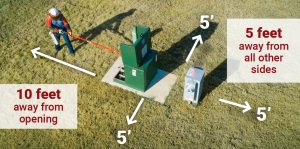Home » Safety at Home
Safety at Home
Home is often where we feel safest, but accidents can happen. Protect yourself and your loved ones with these tips.
During outages:
- Please do not assume another member has reported outages in your area. To get your power restored as quickly as possible, report your outage by texting “outage” to 25022, by calling 888-883-3379, using the SmartHub app, or by logging into your account.
- Unplug major appliances to protect them when power comes back on. In the event of any extended outage, it is safest to unplug all electronics.
- Don’t open the refrigerator or freezer doors. Unopened, your refrigerator will keep food cold for about four hours without power, and your freezer will keep food cold for about 48 hours.
- Leave a light switch turned on so you know when power is restored.
- In winter, wrap yourself in layers of warm clothing, beginning with thermal undergarments. Fill containers with water and drain the pipes to keep them from bursting. In extreme cold, group together in one room and seal off any drafts.
- Never burn charcoal indoors for heat or cooking. Burning charcoal releases carbon monoxide, which can be deadly unless burned in a well-ventilated area.
Stay in touch: Visit our Outage Center on your phone or tablet to track crews’ restoration efforts.
- Trimming trees near electrical equipment is dangerous — never do it yourself. Electricity can jump from the lines to your body, your tools, or nearby branches, causing injury or even death.
- If you see trees growing near our lines or facilities, request free tree-care service online or call us at 888-554-4732, Monday through Friday, between 8 a.m. and 5 p.m. A service order will be issued, and we’ll contact you to send a crew to safely clear the vegetation.
In areas with underground electric service, do not plant shrubs or other vegetation around pad-mounted transformers or otherwise hide or block access. Obstructions near this equipment will make maintenance work hazardous and difficult for crews and may increase outage times.
Ten feet of clearance is needed in front of equipment so crews can safely open it, and 5 feet on each side allows easy access. Some larger pad-mounted electrical equipment requires 10 feet of clearance in the front and back.

When planning to dig 16 inches or deeper, state law requires that you call 811 or sign in to the Texas811 Portal and submit your location at least 48 hours in advance to locate underground electric lines.
Questions about someone on your property? All PEC crews and contractors carry ID — just ask or call PEC Member Services at 888-554-4732 to verify their identity.
Water and electricity don’t mix. If an electric device contacts water, ground fault circuit interrupter (GFCI) outlets will help protect you from the threat of death by electric shock. Here is some information about these vital devices:
- You’ll usually find GFCI outlets where electricity and water could mix, such as in kitchens and bathrooms.
- GFCI outlets monitor the electricity flowing in and out of a product. If the electric current fluctuates, the outlet shuts the power off to prevent shock.
- Test your GFCI outlets once a month. Plug in a nightlight and turn it on. Push the “Test” button; the light should go off. Push the “Reset” button to turn the light back on.